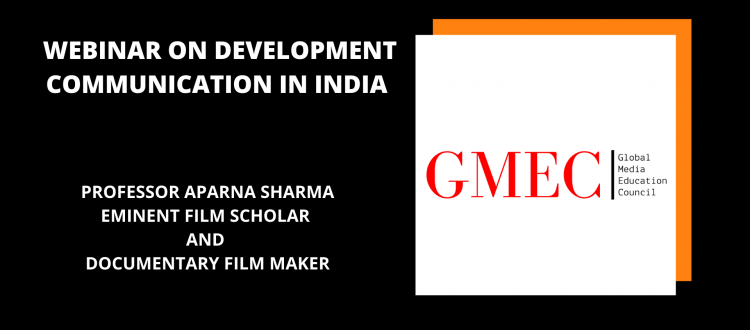Webinar on Development Communication in India – Professor Aparna Sharma
Professor Aparna Sharma talked about Community Video and its role in Development
Communication in India. The topic for her Presentation was “Community Video: Varied Needs and
Methods”.
On the outset she gave a brief statistical overview of the very vast and highly evolved media
landscape of India. She shared the statistics of mainstream and alternative media outlets in the
country. Emphasizing the significance of community videos amidst this evolving landscape, Professor
Sharma has provided some definition of the terminology. Community videos are created for, by, of
and about a community. They take up local issues from a community’s standpoint. Their audiences
are primarily collective and they engage with community media with the objectives to use that
media to address immediate concerns and improve development of the community. The media,
here, unlike its mainstream counterparts, is believed to be a vehicle of some kind of action. It is
practiced with a desire to address the poverty of the communities, whose everyday lives do not
make it to the big screens or the institutionalized modes of media representations.
She has discussed the methodological approaches related to community video and observed that it
is not a singular or staple practice. It is a heterogeneous practice and concept in terms of media
forms, methods of production, media management, aims and objectives as well as their audience
outreach. Appreciation of the differences in the practices, will facilitate a more critical and
historicized appreciation for this mode of media-making. Community media emerges as a response
to highly specific social and cultural contexts. Hence, they need to be studied or appreciated from
their context of production and use.
Out of the three case studies, Professor Sharma has used to analyze the context base methods of
community video initiatives in the country, the first focuses on the video unit of Self Employed
Women’s Association (SEWA), a prominent grass root women empowerment organization
established in 1972. Much before the popularization of the idea of using media for community
development and widespread of internet, SEWA developed a video unit in the year 1984. Today
1100 women are associated with video SEWA. By initiating trainings at grassroots, for advocacy on
rural and urban development issues, SEWA’s videos focus on the needs of the members. Video ideas
are generated by grass root volunteers on issues related to women. Screenings of their videos,
associated with FGDs, aims to generate awareness with a problem-solving approach. Working on
gender sensitivity, they also take integrate initiatives with community and public-service radio units.
Second case study is on Drishti, an organization of skilled filmmakers who train and empower
communities to tell their own stories. Drishti has two areas of focus. They focus the issues that
propel the marginalization of communities within society. Drishti also document indigenous cultural
practices. Board of people, who live and work with the community, discusses possible ideas with
community needs for media-making. Community producers draft film ideas, connect with the
community, perform researches and finally identify solutions. Drishti empower the community
producers to script, storyboard and film. Screenings of these films are coupled with feedback
mechanism, FGDs and problem-solving initiatives. Drishti’s media work has two distinguish
characters-
Built on the principle to offer evidence on how marginalization, discrimination and
exclusion occur in communities.
Works on the principle to demystify technology and other aspects of filmmaking.
Their approach breaks the hegemonic narratives and rationalization with a view to promote
communities’ ability to tell their stories, in their own way.
Third case under study, Microsoft Research Project Digital Green, established in the year 2006,
focuses on agricultural and farming practices, health and nutrition. Emphasizing on visual appeal and
highly localized content they function through a process of initiation or the community outreach,
production of the media by the community and diffusion. The model is based on the community, to
create and share content with each other. They work for the integration of community video within
the framework of govt. agencies on one hand and community specific agricultural context on the
other. With an increasing use of mobile-based filmmaking, often in vernacular language, despite
coming from a corporate structured model, they work with highly specialized local contents for
targeted local audiences.
Analyzing all these cases Professor Sharma has observed that community video practices are diverse
and while focusing on local communities, they offer highly specialized contents, geared for
development and action. However, despite the difference in approach, such practices usually follow
a similar arc: community outreach and ideation, capacity-building and production, dissemination and
outcome generation followed with feedback. She has concluded with the observation that
community video initiatives are specialized not only in content and form, but access to audiences.
Thus they have high level of use and impact in the everyday lives of ordinary people.

